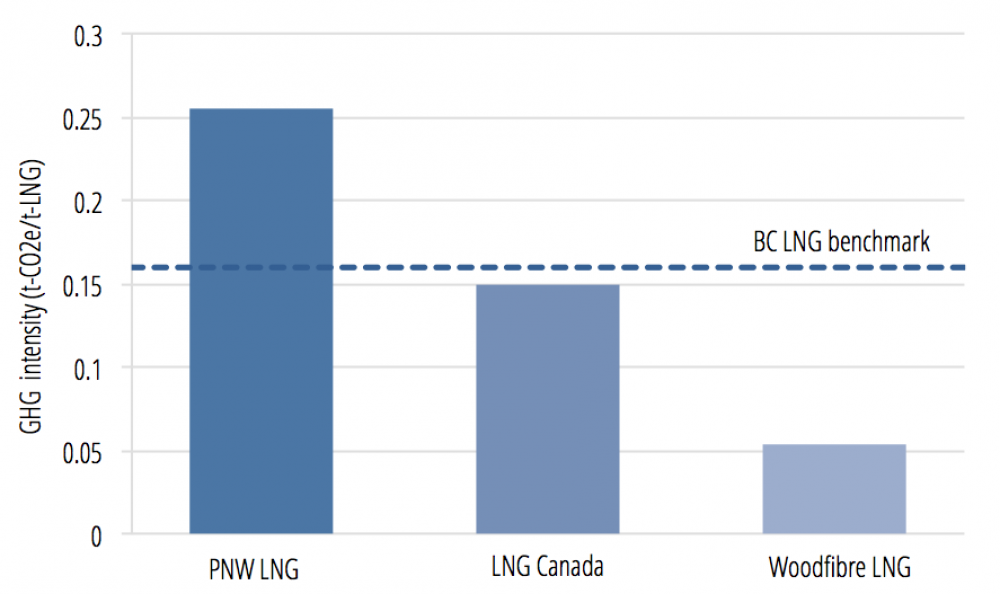Earlier this week, 90 scientists and climate experts sent an open letter to Prime Minister Justin Trudeau expressing their concerns about the potential climate impacts of the Pacific NorthWest LNG project. In response, B.C. minister of environment Mary Polak told a newspaper that the total carbon pollution from the liquefied natural gas project would be lower than estimated by the Canadian Environmental Assessment Agency because of the province’s forthcoming climate plan — much lower, in fact.
The CEAA has estimated that Pacific NorthWest LNG and its associated upstream operations would emit at least 11.4 million tonnes of carbon pollution per year. However, Minister Polak pegged the annual emissions at 3.7 million tonnes, or 68 per cent lower than the federal agency.
Questioning the math
Could Pacific NorthWest LNG’s carbon pollution be lower than reported by the CEAA? Absolutely. After all, an effective B.C. climate plan must include policies that significantly reduce carbon pollution from any LNG development and the natural gas sector.
Could the carbon pollution be 68 per cent lower based on the actions discussed by Minister Polak? No. There are two problems underlying the minister’s 3.7 million tonne estimate. Correcting these problems puts the number closer to the agency’s estimate.
Problem 1: The B.C. government only accounts for the first phase of the project
Pacific NorthWest LNG is proposing to build the project in two phases. These are both included in the CEAA’s assessment because that full scope is what the company is asking the federal government to approve. The B.C. government’s estimate only accounts for the first phase. Including the second phase would push the numbers up by 50 per cent.
Problem 2: The B.C. government doesn’t account for deficiencies in its LNG legislation
The B.C. government’s estimate assumes that the carbon intensity of the Pacific NorthWest LNG terminal would be 0.16 tonnes of carbon pollution per tonne of LNG produced. This is the benchmark that the province legislated in 2014, but that legislation doesn’t actually require LNG projects to meet the benchmark.
That’s because, instead of being required to meet the benchmark, LNG projects are allowed to purchase carbon offsets, pay into a technology fund, or buy emission credits from other LNG projects that are below the benchmark. None of these options offer guarantees that carbon pollution will be reduced (see Section 7 of the Pembina Institute’s letter to the CEAA about the project for more details).
As shown below, two of the three leading LNG projects in B.C. are proposing to get below the benchmark. Pacific NorthWest LNG isn’t one of them, and its carbon intensity of 0.26 is more than 50 per cent above the benchmark. That’s not to say Pacific NorthWest LNG couldn’t get to the benchmark, but they aren’t currently proposing this.
Correcting the math
When you account for both phases of the project and the actual anticipated carbon pollution from the LNG terminal, the total estimate jumps to between 7.4 million and 10.4 million tonnes per year. The lower end of the range assumes that methane emissions are reduced significantly and upstream operations are powered mostly by renewable electricity instead of gas.
These shifts are possible, but they will require new climate policies. If those policies don’t materialize, the upstream improvements won’t happen and the province’s estimate would change to 10.4 million tonnes. That’s almost all the way back to the agency’s estimate of 11.4 million tonnes.
(The CEAA’s estimate of at least 11.4 million tonnes of carbon pollution is still above my revised B.C. estimate of 10.4 million tonnes. One possible explanation for the difference is an assumption by B.C. that the gas would come from the Montney basin instead of a mix of basins. The Montney basin has almost no carbon dioxide present in the raw gas, so the resulting carbon pollution is lower than from other basins like the Horn River that have high concentrations of carbon dioxide in the raw gas.)
Getting back on track
Last fall, the Climate Leadership Team gave the B.C. government a blueprint for a new climate plan that would allow the province to get back on track to its climate targets and maintain a strong economy. With the plan anticipated to land this month, we’ll be looking closely to see how much it will do to reduce carbon pollution from all sectors of the province, including LNG and natural gas. Encouragingly, Environment and Climate Change Canada is planning to do the same.
The big test will be whether the policies in the plan put the province on a credible path to achieving its climate targets. With climate action stalled since 2012, B.C.’s carbon pollution has been going up and is projected to rise by 32 per cent between now and 2030 in the absence of new policies. We’ll see if the math checks out.
This commentary originally appeared in the Georgia Straight.












